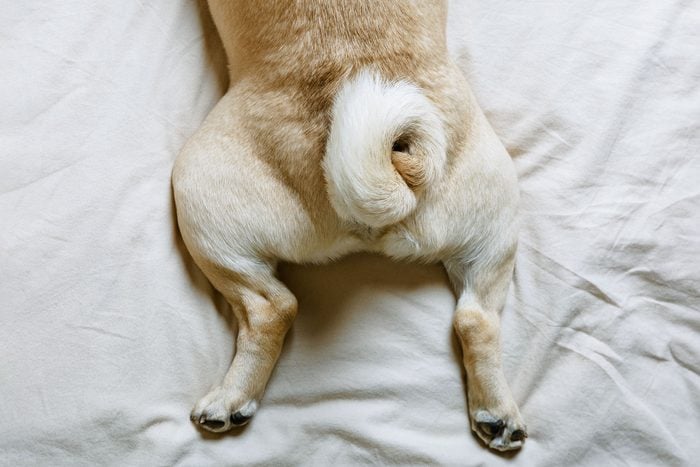
All hail the curly tail!
Dogs use their wagging appendages for more than just charming their favorite humans. They use their tails to communicate with other dogs, animals and us, explains veterinarian Shannon Barrett, DVM. Tails come in all shapes and sizes—fluffy, furry, short, stubby, long—but what is cuter than those dogs with curly tails?
Curly tails are usually the result of selective breeding. That is, dogs with curly tails have been carefully bred to continue sporting this unique feature. But curly tails sometimes seem to have arisen by chance—for example, in the primitive basenji. These tails aren’t just adorable; they can be functional too. Veterinarian Amy Attas, DVM, says that breeds like basenjis, Akitas and even Pomeranians use their curled tails to aid their movement while working. In colder climates, breeds like Norwegian buhunds and Samoyeds sport their curls for extra warmth.
Some of the most popular dog breeds amp up their adorableness to another level with a permanent curlicue. If you’re feeling smitten by these playful spirals, you’re in luck. Ahead, we’ve spoken with Dr. Barrett and Dr. Attas to round up 13 pups who flaunt curly tails and so much more.
Get Reader’s Digest’s Read Up newsletter for more pet insights, humor, travel, tech and fun facts all week long.
About the experts
|
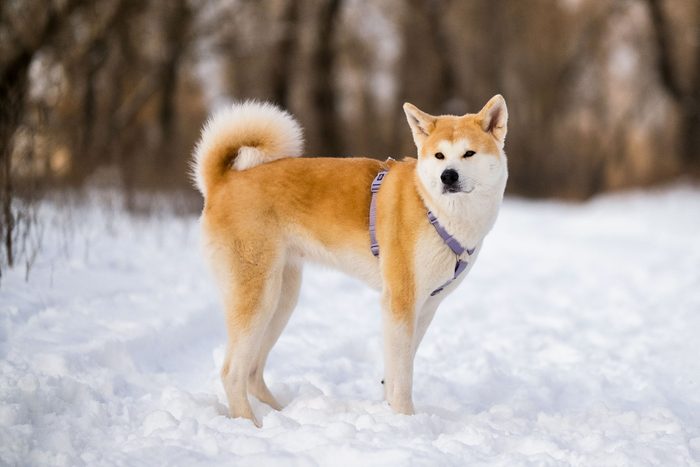
Akita
Dr. Barrett’s favorite dog with a curled tail? The Akita. Standing 24 to 28 inches tall and weighing up to 130 pounds, Akitas are no doubt large dogs, and their fluffy tails that curl over their backs add to their impressive looks. But don’t let their size fool you. “Even though they look intimidating, they are big babies—very sweet and smart,” Dr. Barrett says.
Sure, a little more grooming is involved when an Akita is part of the family—they have a thick double coat that sheds—but Akitas are totally worth it. “They are incredibly loyal to their family and often form a strong bond with one person,” she says. Plus, they don’t tend to bark unless there’s a good reason.
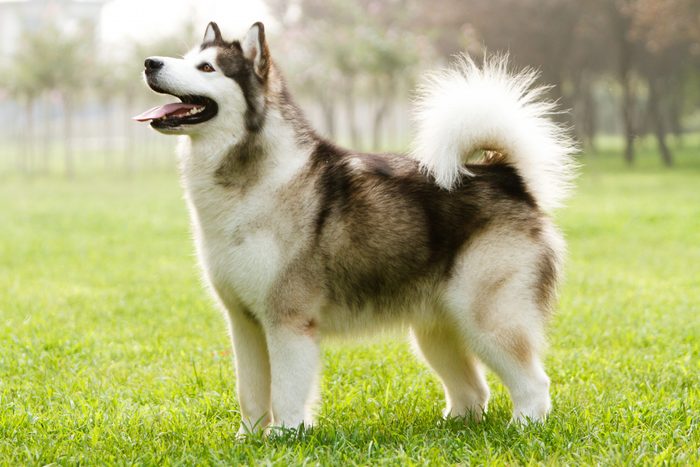
Alaskan malamute
The curly-tailed Alaskan malamute isn’t just Alaska’s state dog; it’s also a popular choice for active families across the United States. Known for their friendly, outgoing and playful personalities, malamutes make excellent companions for families with older children, according to Dr. Barrett. However, these escape artists require constant vigilance—walks on a leash and secure yards are a must.
In addition to the plumed tail that arches over their back, Alaskan malamutes boast a dense double coat with a wooly undercoat and coarse guard hairs. This beautiful fur comes with a grooming responsibility for pet parents. Dr. Barrett says that malamutes “blow” (shed) their undercoat twice a year during spring and fall. Daily brushing will manage the shedding fur.
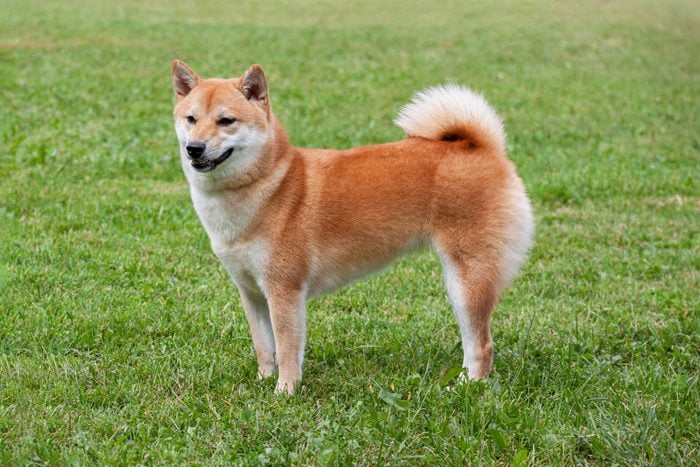
Shiba Inu
The Shiba Inu stands out not only for its curled tail but also for its striking resemblance to a fox. These poofy pups boast a signature red-orange coat and white chest (but sometimes black and tan) that’s accented by perky ears. Of course, their captivating looks aren’t the only thing that makes them special. Shibas are known for their unique vocalization, the “Shiba scream,” as it’s known. According to Dr. Barrett, this loud outburst can signal either extreme happiness or displeasure.
The Japenese dog breed was historically used as a hunting dog that could flush birds and other small game out of the brush, according to the American Kennel Club (AKC). So it’s possible that its curled tail helped it navigate dense brush and burrows with greater ease and fewer snags.
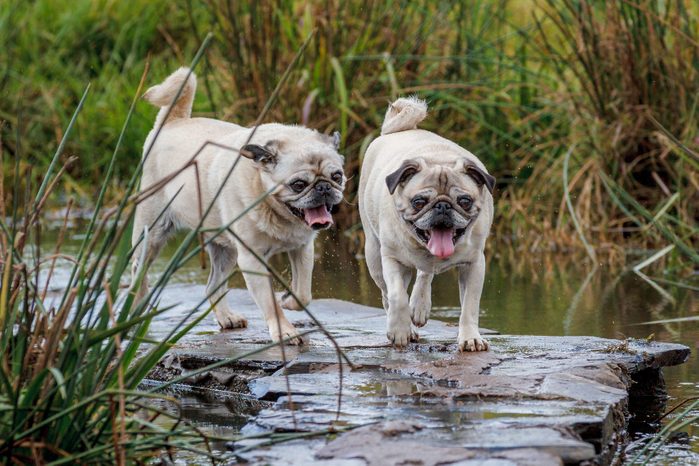
Pug
Dr. Attas finds the pug’s tightly curled tail at the rump particularly adorable. “I often get asked if I have to set my pug’s tail each night,” she says with amusement. She adds that the curlicue “perfectly complements” their round head and is especially charming when wagging with enthusiasm. Bred solely for companionship, these dogs have curly tails for what’s believed to be purely aesthetic reasons. And while it serves no working purpose, it’s hard to deny that the pug’s corkscrew tail adds to its charm.
Like other dogs with curly tails on this list, pugs boast personalities that extend far beyond their cute looks—they are known for being outgoing, humorous and loving companions. However, Dr. Barrett cautions that they have food-motivated tendencies. “Since they are considered a brachycephalic [flat-faced] breed, keeping them lean is essential,” she says.
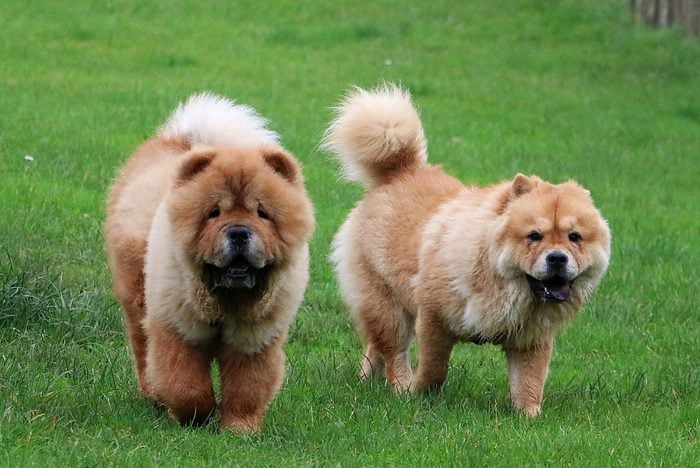
Chow chow
We can’t think of any cats with curled tails, but we know of one curly-tailed dog that acts more like a cat than any other pup: the strong-willed chow chow. Even their hygiene habits are reminiscent of feline friends. “They are meticulous groomers who lick their paws and clean their faces,” Dr. Attas says. And unlike many dogs, barking isn’t on their list of favorite things to do.
When it comes to looks, everything about chow chows is poofy, including the tails that curl and arch gracefully over their backs.
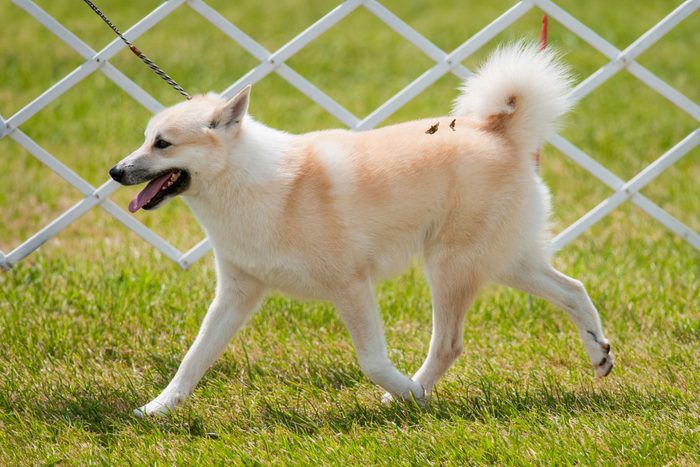
Norwegian buhund
Hailing from Norway, the buhund (meaning “farm, homestead or mountain hut” in Norwegian) was historically an all-purpose farmhand. According to the Norwegian Buhund Club of America, these dogs herded livestock and guarded farmsteads during summer months, which they can still be found doing today in rural parts of the country. Built for the harsh Nordic climate, the buhund boasts a thick double coat and curled tail, hallmark features of spitz breeds, such as Akitas and chow chows. Dr. Attas suggests their curled tails might provide an extra layer of warmth.
While most modern buhunds may not be wrangling sheep, they remain active pups. The club highlights their love for a range of activities, from obedience training to agility sports, hiking, tracking and even therapeutic work.

Basenji
Often called the “barkless dog,” the basenji sports a short tail that curls tightly at its lower back. A curled tail slung over its back is likely a better position for hunting because it’s less likely to wack trees, collect burrs and snag on the underbrush, Dr. Attas says. However, don’t be misled by the basenji’s nickname. According to Dr. Attas, these ancient hunting dogs were bred to be quieter hunting companions, and instead of barking, they make a unique yodel-like sound.
Despite their hunting instincts (which come with a strong prey drive), basenjis can be wonderful companions for families if they have proper training and socialization. While they can live peacefully with kids, other dogs and even cats, supervised interactions are always recommended.
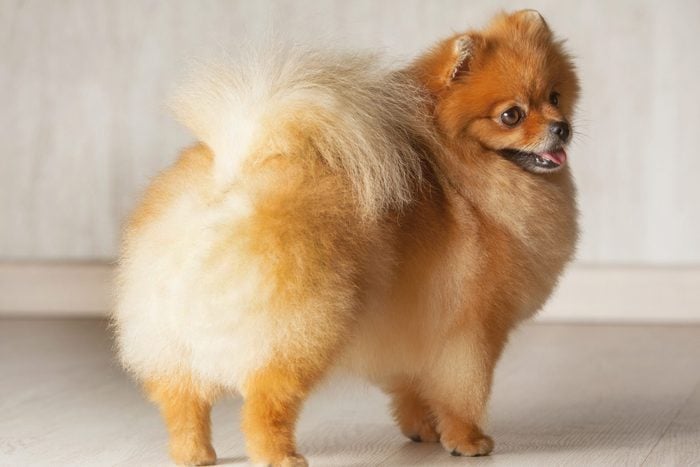
Pomeranian
If you fancy a dog that can fit in the crook of your arm, a floofy Pomeranian might be the pet for you. Weighing just 3 to 7 pounds, “Pomeranians pack a big punch in a little body,” Dr. Attas says. Poms were originally much larger vermin hunters and retained their big-dog spirit in a pint-size body, she says. Their curled tails likely aided them in flushing out prey.
It might come as no surprise that this fluff ball requires dedicated grooming. “They have a dense double coat that requires daily brushing to remove loose hair, distribute their natural oils through the coat and prevent tangles and mats,” Dr. Attas says. And that cute curly tail? She recommends keeping the fur under it trimmed short to avoid hygiene issues. But with a face that melts hearts and a personality to boot, a little grooming seems a small price to pay for happy Pomeranian smooches.
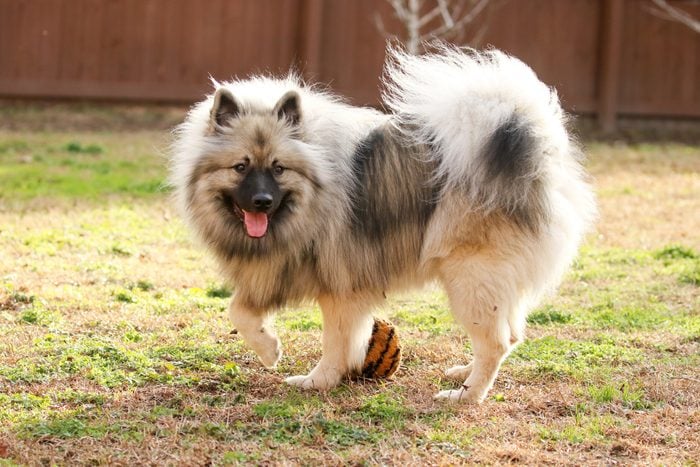
Keeshond
Descended from the spitz family, keeshonds (pronounced kayz-hawnd) have an interesting history as watchdogs and companions. According to the Keeshond Club of America, these gentle dogs accompanied Dutch sailors on barges, leaping from ship to shore, barking at strangers and watching over children, for whom they have a special fondness.
These large cousins of Pomeranians once earned nicknames like “overweight Pomeranians,” “fox dogs” and “Dutch barge dogs,” the Keeshond Club of America reports. Their distinctive coat features a lion-like mane and a fluffy rump and legs that makes them look as if they’re wearing trousers. And to top off their cuteness: That plumed tail curls over their back.

Finnish spitz
The Finnish spitz is another fox lookalike with bicolored gold and red fur, perky ears and a bushy tail that curls. These medium-sized pups stand up to 20 inches tall and weigh between 20 and 33 pounds.
Full of clever energy, the Finnish spitz requires ample engagement. Dr. Attas recommends interactive toys, food puzzles and plenty of exercise to keep these lively pups out of trouble—like rummaging through the garbage or digging in the yard. Historically prized as the “barking bird dog” of Finland, they’ve even earned the title of national dog in their home country. While their vocal talents were essential for hunting, Dr. Attas cautions potential pet parents that this trait might not be ideal for all living situations.
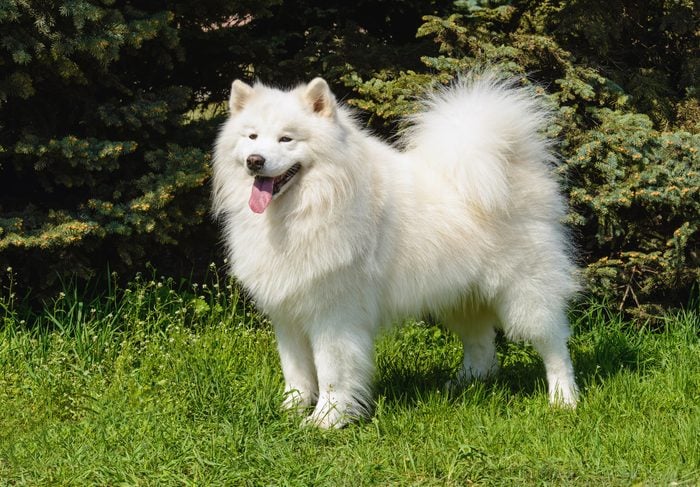
Samoyed
Samoyeds’ infectious “Sammy smiles” are guaranteed to brighten your day. The Samoyed Club of Washington says that these aren’t just goofy grins—because of the natural upturn of their mouths, Samoyeds don’t drool, a trait that prevented the formation of icicles around their muzzles in the cold Siberian areas where they were originally bred. The grin isn’t the only way their body adapted to their Siberian home, where temperatures can plummet to minus 60 degrees Fahrenheit. According to the AKC, they have a thick double coat with a dense, fluffy undercoat. Dr. Attas adds that their curled tails likely help retain body heat as well.
However lovely they are, these furry bundles of joy come with a hefty price tag: They’re one of the most expensive dog breeds in the world.
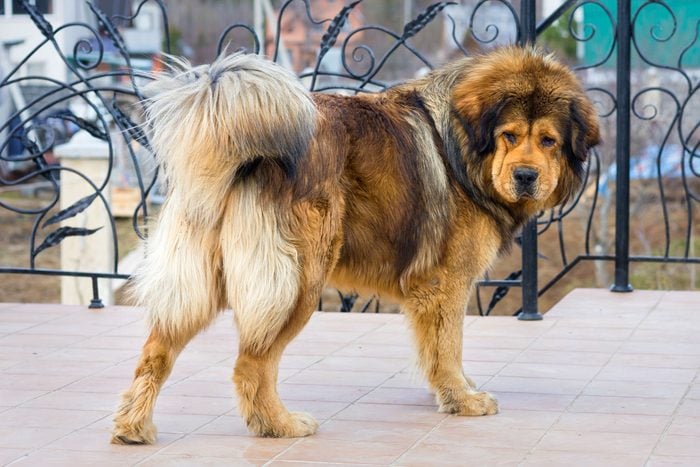
Tibetan mastiff
The Tibetan mastiff is a serious-looking dog that stands 24 to 26 inches tall and weighs 70 to 150 pounds. More lion-like than canine in appearance, they have thick manes and bear-like faces with large muzzles and deep-set eyes. Their bushy tails, as impressive as their manes, sweep over their backs in a grand arch.
Bred for generations to guard livestock and people in the harsh Himalayan Mountains, the Tibetan mastiff retains a strong protective instinct. The Tibetan Mastiff Club of Great Britain says to take socialization and supervision seriously. Without lifelong training, these loyal giants can become overly protective of their families when faced with strangers.
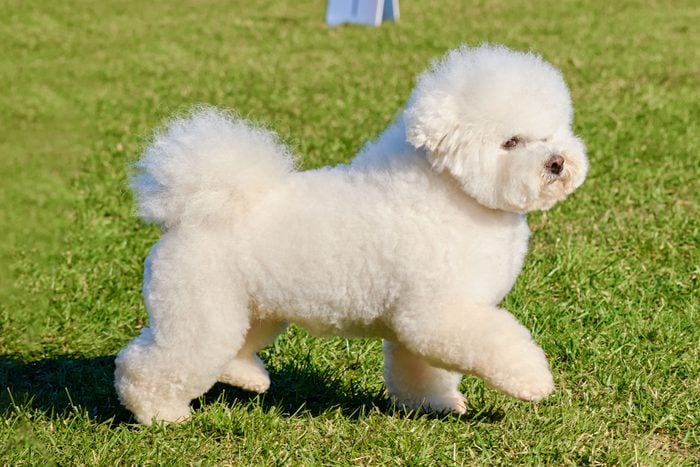
Bichon frisé
The dainty bichon frisé is easy to spot with its cotton-ball fur, stark black eyes and button nose. Adding to the breed’s undeniable charm is a soft-plumed tail that it carries curled over its back.
With looks like these, it’s hard to believe the breed almost vanished at the end of World War II. But it was the dog’s captivating looks that caught the eye of French breeders, who revived the breed, aptly naming it bichon à poil frisé, or “bichon with curly hair,” according to the AKC.
They’re usually friendly and more than a bit silly. While their legs may be small, they have no trouble keeping up in busy households filled with larger dogs, cats and children. End the day offering cuddles, and these happy pups will bid you bonne nuit curled contentedly by your side.
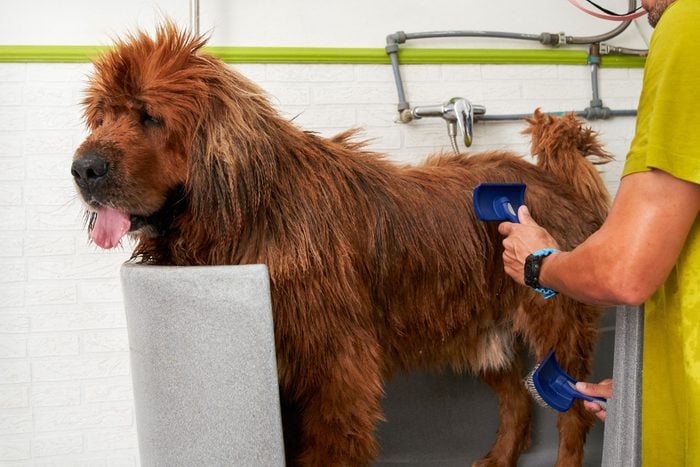
Caring for dog breeds with curly tails
With such cute tails comes a little extra TLC, says Dr. Attas. “Dogs with curly tails can develop an infection in the skin folds of the curled tail,” she says. Keeping the area under the tail clean and dry will prevent bacteria buildup, discomfort and odor. A simple cleaning routine, and sometimes grooming, can often prevent the need for antibiotics.
Why trust us
At Reader’s Digest, we’re committed to producing high-quality content by writers with expertise and experience in their field in consultation with relevant, qualified experts. For this piece, Janelle Leeson tapped her experience as a journalist who covers pets, and then Caroline Coile, PhD, an award-winning journalist specializing in canine breeds, health and science, gave it a rigorous review to ensure that all information is accurate and offers the best possible advice to readers. For this piece, we relied on reputable primary sources and experts, including practicing veterinarians. We verified all facts and data and backed them with credible sourcing, and we will revisit them over time to ensure they remain accurate and up to date. Read more about our team, our contributors and our editorial policies.
Sources:
- Amy Attas, DVM, veterinarian and founder of City Pets; email interview, March 22, 2024
- Shannon Barrett, DVM, veterinarian and founder of Island Veterinary Care; email interview, March 21, 2024
- Keeshond Club of America: “History of the Keeshond”
- Norwegian Buhund Club of America: “About the Breed” and “Breed History”
- Samoyed Club of Washington State: “FAQs”
- Tibetan Mastiff Club of Great Britain: “History of the TM”
- The American Kennel Club: “Bichon Frisé History: Time’s Sociable Survivor”
- The American Kennel Club: “Shiba Inu Facts You May Not Know”

